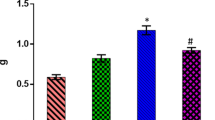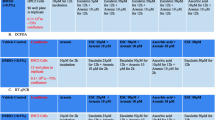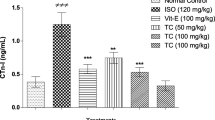Abstract
The present study was designed to investigate the protective effect of ferulic acid (FA) against isoproterenol (ISO)-induced cardiac toxicity in rats. Isoproterenol challenged in a dose of 85 mg/kg body weight (b.w.) subcutaneously for two consecutive days in the experimental group resulted in acute cardiac toxicity as evidenced by changes in electrocardiogram (ECG) pattern and marked elevation of serum cardiac enzymes viz aspartate aminotransferase (AST), alanine transaminase (ALT), creatinine kinase (CK-MB) and lactate dehydrogenase (LDH) also increases inflammatory cytokines. Moreover, acute toxicity effect was exhibited by disturbance in the antioxidant system as decrease in activities of superoxide dismutase (SOD) and glutathione (GSH) with the rise in activities of malondialdehyde (MDA) and nitric oxide (NO). Pre-treatment with FA at the increasing dose of (10, 20 and 40 mg/kg b.w.) orally for 28 consecutive days followed by isoproterenol injection for 2 days significantly attenuated changes in serum cardiac enzymes. Furthermore, histopathological evaluation confirmed the restoration of cellular architecture in FA pretreated rats. The cardioprotective effect of FA was comparable with standard drug treatment metoprolol. Taken together, FA demonstrated cardioprotective effect against ISO-induced cardiac toxicity by normalization of serum cardiac biomarkers, alleviating oxidative stress and augmenting endogenous antioxidant system.




Similar content being viewed by others

References
Anderson JL, Morrow DA (2017) Acute myocardial infarction. N Engl J Med 376:2053–2064
Filippo CD, Cuzzocrea S, Rossi F, Marfella R, D’Amico M (2006) Oxidative stress as the leading cause of acute myocardial infarction in diabetics. Cardiovasc Drug Rev 24:77–87
Bagatini MD, Martins CC, Battisti V, Gasparetto D, Da Rosa CS, Spanevello RM et al (2011) Oxidative stress versus antioxidant defenses in patients with acute myocardial infarction. Heart Vessels 26:55–63
Rani V, Yadav UCS (2014) Free radicals in human health and disease. Springer, New Delhi
Sharman EH (2016) Reactive oxygen species and protein oxidation in neurodegenerative disease. In: Inflammation, aging, and oxidative stress. Springer, Cham, pp 199–212
Bondy SC, Campbell A (2016) Inflammation, aging, and oxidative stress. Springer, Cham
Zhang M, Shah AM (2007) Role of reactive oxygen species in myocardial remodeling. Curr Heart Fail Rep 4:26–30
Festjens N, Berghe TV, Vandenabeele P (2006) Necrosis, a well-orchestrated form of cell demise: signalling cascades, important mediators and concomitant immune response. Biochim Biophys Acta 1757:1371–1387
Banerjee S, Ghosh J, Sil P (2016) Drug metabolism and oxidative stress: cellular mechanism and new therapeutic insights. Biochem Anal Biochem 5:255
Sharma M, Kishore K, Gupta SK, Joshi S, Arya DS (2001) Cardioprotective potential of Ocimum sanctum in isoproterenol induced myocardial infarction in rats. Mole Cell Biochem 225:75–83
Aihara M, Dobashi K, Iizuka K, Nakazawa T, Mori M (2003) Comparison of effects of Y-27632 and Isoproterenol on release of cytokines from human peripheral T cells. Int Immunopharmacol 3:1619–1625
Hassan MQ, Akhtar M, Ahmed S, Ahmad A, Najmi AK (2017) Nigella sativa protects against isoproterenol-induced myocardial infarction by alleviating oxidative stress, biochemical alterations and histological damage. Asian Pac J Trop Biomed 7:294–299
Hussein A (2015) Cardioprotective effects of astaxanthin against isoproterenol-induced cardiotoxicity in rats. J Nutr Food Sci 5:1–6
Rathore N, John S, Kale M, Bhatnagar D (1998) Lipid peroxidation and antioxidant enzymes in isoproterenol induced oxidative stress in rat tissues. Pharmacol Res 38:297–303
Mates J (2000) Effects of antioxidant enzymes in the molecular control of reactive oxygen species toxicology. Toxicology 153:83–104
Bendary E, Francis R, Ali H, Sarwat M, El Hady S (2013) Antioxidant and structure–activity relationships (SARs) of some phenolic and anilines compounds. Ann Agric Sci 58:173–181
Balasundram N, Sundram K, Samman S (2006) Phenolic compounds in plants and agri-industrial by-products: antioxidant activity, occurrence, and potential uses. Food Chem 99:191–203
Itagaki S, Kurokawa T, Nakata C, Saito Y, Oikawa S, Kobayashi M, Hirano T, Iseki K (2009) In vitro and in vivo antioxidant properties of FA: a comparative study with other natural oxidation inhibitors. Food Chem 114:466–471
Kanski J, Aksenova M, Stoyanova A, Butterfield DA (2002) FA antioxidant protection against hydroxyl and peroxyl radical oxidation in synaptosomal and neuronal cell culture systems in vitro: structure-activity studies. J Nutr Biochem 13:273–281
Kumar N, Pruthi V (2014) Potential applications of FA from natural sources. Biotechnol Rep 4:86–93
Srinivasan M, Sudheer AR, Menon VP (2007) FA: therapeutic potential through its antioxidant property. J Clin Biochem Nutr 40:92–100
Yogeeta SK, Gnanapragasam A, Kumar SS, Subhashini R, Sathivel A, Devaki T (2006) Synergistic interactions of FA with ascorbic acid: its cardioprotective role during isoproterenol induced myocardial infarction in rats. Mol Cell Biochem 283:139–146
Chander Hass Yadav M, Khanam R (2014) Isoproterenol toxicity induced ECG alterations in wistar rats: role of histamine H3 receptor agonist imetit. IJPPS 6:23–33
Rao PR, Kumar VK, Viswanath RK, Subbaraju GV (2005) Cardioprotective activity of alcoholic extract of Tinospora cordifolia in ischemia-reperfusion induced myocardial infarction in rats. Biol Pharm Bull 28:2319–2322
Lalitha G, Poornima P, Archanah A, Padma VV (2013) Protective effect of neferine against isoproterenol-induced cardiac toxicity. Cardiovasc Toxicol 13:168–179
Adil M, Visnagri A, Kumar VS, Kandhare AD, Ghosh P, Bodhankar S (2014) Protective effect of naringin on sodium arsenite induced testicular toxicity via modulation of biochemical perturbations in experimental rats. Pharmacologia 5:222–234
Aswar UM, Kandhare AD, Mohan V, Thakurdesai PA (2015) Anti-allergic effect of intranasal administration of type-A procyanidin polyphenols based standardized extract of cinnamon bark in ovalbumin sensitized BALB/c mice. Phytother Res 29:423–433
Badole SL, Chaudhari SM, Jangam GB, Kandhare AD, Bodhankar SL (2015) Cardioprotective activity of Pongamia pinnata in streptozotocin-nicotinamide induced diabetic rats. BioMed Res Int 2015:403291
Goswami S, Kandhare A, Zanwar AA, Hegde MV, Bodhankar SL, Shinde S, Deshmukh S, Kharat R (2016) Oral l-glutamine administration attenuated cutaneous wound healing in Wistar rats. Int Wound J 13:116–124
Kumar VS, Rajmane AR, Adil M, Kandhare AD, Ghosh P, Bodhankar SL (2014) Naringin ameliorates acetic acid induced colitis through modulation of endogenous oxido-nitrosative balance and DNA damage in rats. J Biomed Res 28:132
Raygude KS, Kandhare AD, Ghosh P, Bodhankar SL (2012) Anticonvulsant effect of fisetin by modulation of endogenous biomarkers. Biomed Prev Nutr 2:215–222
Saraswathi K, Muthal A, Kandhare A, Rojatkar S, Bodhankar S (2014) Study of methanolic extract of Artemisia pallens wall on endurance of laboratory animals. Pharmacologia 5:298–309
Sumitra M, Manikandan P, Kumar DA, Arutselvan N, Balakrishna K, Manohar BM, Puvanakrishnan R (2001) Experimental myocardial necrosis in rats: role of arjunolic acid on platelet aggregation, coagulation and antioxidant status. Mol Cell Biochem 224:135–142
Nirmala C, Puvanakrishnan R (1996) Protective role of curcumin against isoproterenol induced myocardial infarction in rats. Mol Cell Biochem 159:85–93
Patel V, Upaganlawar A, Zalawadia R, Balaraman R (2010) Cardioprotective effect of melatonin against isoproterenol induced myocardial infarction in rats: a biochemical, electrocardiographic and histoarchitectural evaluation. Eur J Pharmacol 644:160–168
Padmanabhan M, Prince PSM (2007) S-allylcysteine ameliorates isoproterenol-induced cardiac toxicity in rats by stabilizing cardiac mitochondrial and lysosomal enzymes. Life Sci 80:972–978
Lim KH, Ko D, Kim JH (2013) Cardioprotective potential of Korean Red Ginseng extract on isoproterenol-induced cardiac injury in rats. J Ginseng Res 37:273
Meeran MFN, Jagadeesh GS, Selvaraj P (2015) Thymol attenuates inflammation in isoproterenol induced myocardial infarcted rats by inhibiting the release of lysosomal enzymes and downregulating the expressions of proinflammatory cytokines. Eur J Pharmacol 754:153–161
Zhang J, Knapton A, Lipshultz SE, Weaver JL, Herman EH (2008) Isoproterenol-induced cardiotoxicity in sprague-dawley rats: correlation of reversible and irreversible myocardial injury with release of cardiac troponin T and roles of iNOS in myocardial injury. Toxicol Pathol 36:277–278
Acknowledgements
The authors gratefully acknowledge the financial support received under Research Promotion Scheme (RPS, File No. 8-79/RIFD/RPS/POLICY-1/2016–17) of All India Council for Technical Education, New Delhi, India.
Author information
Authors and Affiliations
Corresponding author
Ethics declarations
Conflict of interest
The author(s) declare(s) that there is no conflict of interest regarding the publication of this paper.
Rights and permissions
About this article
Cite this article
Jain, P.G., Mahajan, U.B., Shinde, S.D. et al. Cardioprotective role of FA against isoproterenol induced cardiac toxicity. Mol Biol Rep 45, 1357–1365 (2018). https://doi.org/10.1007/s11033-018-4297-2
Received:
Accepted:
Published:
Issue Date:
DOI: https://doi.org/10.1007/s11033-018-4297-2



